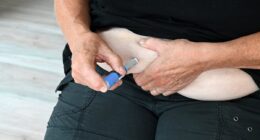
Jynneos is the preferred vaccine that health authorities are focusing on distributing to fight the current outbreak, William Schaffner, MD, infectious disease specialist and professor of medicine at the Vanderbilt University School of Medicine, tells SELF. Jynneos is a live virus vaccine that’s given like most traditional vaccines—via a needle in your arm, the CDC says. Two injections are given spaced four weeks apart; you aren’t considered fully vaccinated until it’s been two weeks after you receive the second dose of the vaccine.
ACAM2000 is also a live virus vaccine, but it’s given by pricking the surface of your skin, the CDC explains. A “take,” which is a lesion, will form at the site of the prick. Here’s why this isn’t the preferred option right now: The virus that grows at the lesion can spread to other parts of the body and to other people if contact is made. People who are vaccinated with the ACAM2000 vaccine have to take special precautions to avoid spreading the virus to other parts of their body or to other people. This option only requires one shot and you are considered fully vaccinated after 28 days.
What are the potential side effects of the monkeypox vaccine?
You can generally expect some cold- or flu-like symptoms for a few days after any type of vaccine. This is totally normal since your body is working hard to build an immune response.
The FDA says you may experience the following side effects after you receive the Jynneos vaccine: pain, swelling, inflammation, or itching at the injection site; muscle pain; headache; fatigue; nausea; fever; and chills.
READ RELATED: The #1 Best Vegetable for a Flat Belly, Says Dietitian
The ACAM2000 vaccine isn’t being widely used right now, but if you were to receive it, the FDA says you could potentially face the following side effects: pain, swelling, inflammation, or itching at the injection site; fever; chills or feeling hot; lymph node swelling; skin rash or other skin reactions; headache; muscle pain; fatigue; and digestive distress.
Smallpox vaccines have historically left a scar on a person’s arm where the lesion forms, but that’s not the case with the Jynneos vaccine. “ACAM2000 can cause something of a scar,” Dr. Schaffner says. “But Jynneos is injected the same as every other vaccine and does not cause a scar.”
How to take care of yourself after getting vaccinated
“Post-vaccine symptoms vary from person to person and there’s no one-size-fits-all recommendation,” Amesh A. Adalja, MD, infectious disease expert and senior scholar at the Johns Hopkins Center for Health Security, tells SELF.
Still, you should prepare to feel a bit crummy for a few days, Thomas Russo, MD, professor and chief of infectious disease at the University at Buffalo in New York, tells SELF. Again, this is really common and shouldn’t worry you. “It’s like every other vaccine,” he says. It’s possible you may have some reactive side effects, so “listen to your body” and only “do what you feel up to.”
Source: SELF









